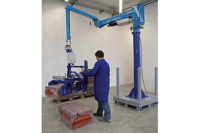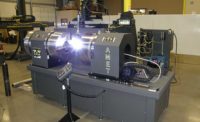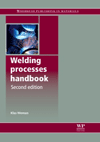Initially East End Welding used shielded metal arc welding. Unfortunately, it was time consuming because each end cap requires preheat and interpass temperatures, as well as a complete-penetration, multiple-pass weld. Also, because the header is 17 feet long, it was prone to awkward overhandling during fabrication.
In 2009, Susong looked into alternate methods of welding. He visited Lincoln Electric Automation in Cleveland to view a demonstration of a submerged arc welding (SAW) system using a robot.
Susong liked that SAW delivers sound weld deposits that are low in hydrogen and fuse well with parent materials. He also learned that SAW would allow East End welders to rotate the torch head instead of rolling the headers during fabrication. This action shortens the time required to make finished welds, increasing operational efficiency and improving finished weld quality.
Near the end of 2009, East End installed the SAW system with the help of Lincoln Electric and their distributor Praxair Distribution. Together, they planned the welding sequence, the issue of controlling heat input and interpass temperature, and the consistent delivery of wire and flux to the weld joint.
The SAW system features a FANUC M-710 robot with 12-foot reach. Robot controls are integrated with a Power Wave 1000 SD welding power source. The system also includes a pressurized flux delivery and recovery system that ensures concentric flux coverage to the weld joint.
Six header assemblies are placed in a fixture designed by East End. This fixture holds each end cap in the flat welding position of 1G, and allows East End to robotically weld most of the headers it welds. Both end caps of the header assembly are welded.
During the process, a 3/32-inch-diameter solid electrode (wire or coil) is fed to the robot-mounted welding head and submerged under a blanket of Lincolnweld 960 arc flux, which has a preconditioning temperature of 350 F.
The robot moves from header assembly to header assembly, making one weld on each end cap per pass. Once welding is completed on one end (after about 20 passes), the header is lifted from the tooling and rotated 180 degrees to allow for the welding of the other end cap.
This method allows for easier maintenance of the required interpass temperature, as well as reduced cleaning of used flux between passes. All of the welding uses AC current for the fill passes and then AC or DC+ (deeper penetration) for the cap passes.
The Power Wave 1000 SD allows the operator to adjust time and current magnitude during each half cycle and the frequency of the AC output.
For more information on robotic submerged arc welding, call 216-481-8100 or visit www.lincolnelectric.com.










